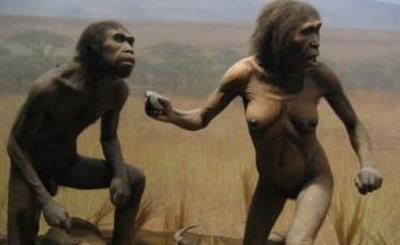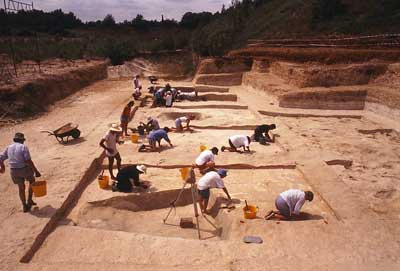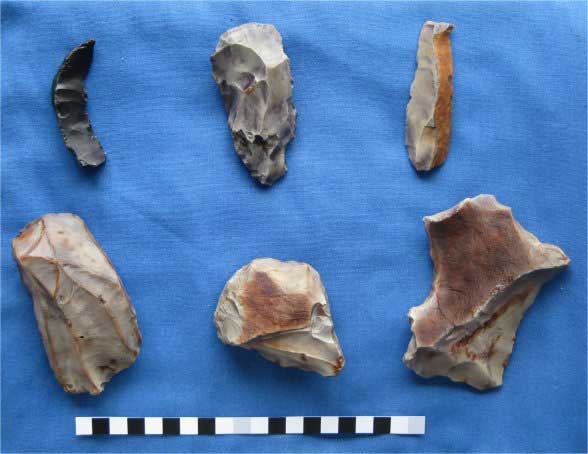
African Erectus
Neil Faulkner Archive | ETOL Main Page
Marxist History
Published online by Counterfire, 3 June 2010.
Copied with thanks from the Counterfire Website.
Marked up by Einde O’Callaghan for the Encyclopaedia of Trotskyism On-Line (ETOL).
In the first of a regular series, Neil Faulkner charts the evolutionary development of modern day humans from primitive apes to socially co-operative human beings.

African Erectus |
new form of archaic ape roamed the Afar Depression of Ethiopia 3.2 million years ago: Australopithecus afarensis (meaning ‘Southern Ape of Afar’). Anthropologists recovered 47 fossil bones of one of these ‘australopithecines’ in 1974 – 40 % of a complete skeleton.
From her slight ‘gracile’ form, they assumed she was female and dubbed her ‘Lucy’ (though she may have been male).
She stood just 1.1 m tall, weighed around 29 kg, and was probably about 20 when she died. Of modest size and with short legs, long arms and small brain-case, Lucy would have looked rather like a modern chimpanzee.
But there was a crucial difference: she walked upright. The shape of her pelvis and legs – and the knee-joint of another member of the species found a short distance away – proved this beyond reasonable doubt.
Lucy was probably one of a small foraging band that moved around the landscape gathering fruit, nuts, seeds, eggs, and other foodstuffs.
As climate change reduced the forests and created savannah, natural selection had favoured a species able to range over greater distances in search of food.
But Lucy’s ‘bipedalism’ (two-legged walking) had revolutionary implications. It freed the arms and hands for tool-making and other forms of labour. This, in turn, encouraged natural selection in favour of higher brain capacity.
A powerful dialectic of evolutionary change was set in motion: hand and brain, labour and intellect, skill and thought began that explosive interaction whose culmination would be modern day humans.
We do not know whether Lucy herself made tools. None were found in association with her remains or those of her companions. But 2.5 million years ago, Lucy’s descendants were certainly doing so. Choppers made from crudely chipped pebbles represent the archaeological imprint of a new family of species defined by tool-making behaviour: the hominids. Tools embody conceptual thought, forward planning, and manual dexterity.
They reveal the use of intellect and skill to modify nature so as to exploit its resources more efficiently. Other animals simply take it as it comes. The hominids, like the australopithecines before them, were forged in Africa, and for about 1.5 million years, that is where they largely remained.
Although 1.8-million-year-old fossil remains have been found in Georgia, near the Black Sea, these appear to represent only a brief foray into Western Asia.
Not until about a million years ago did a species of archaic human – Homo erectus – migrate from Africa to colonise much of South and East Asia. Later again, a more developed hominid – Homo heidelbergensis – settled much of Western Asia and Europe. But populations were tiny and unstable. Hominids are creatures of the Ice Age which began 2.5 million years ago.
Ice Age climate is dynamic, shifting between cold ‘glacials’ and relatively warm ‘interglacials’. We are currently living in an interglacial, but 20,000 years ago was the middle of a glacial. Much of Northern Europe and North America was covered in ice-sheets up to 2.5 miles thick. Winters lasted nine months, and temperatures were below −20 >°C for weeks on end.

Boxgrove excavation |
The early hominids were not adapted to the cold, so they migrated north in warm periods, and moved south again when the glaciers advanced. They first visited Britain, for example, at least 700,000 years ago, but thereafter retreated and returned at least eight times.
Britain was probably occupied for only about 20% of its Old Stone Age (c. 700,000–10,000 BC). Homo heidelbergensis seems to have inhabited coastal or estuarine regions, where animal resources were rich and varied. Her or his standard tool was either an ‘Acheulian’ handaxe (essentially a chopper) or a ‘Clactonian’ flake (a cutter). These general-purpose tools were mass-produced as needed.
Excavations at Boxgrove in Sussex recovered 300 handaxes (and much associated knapping debris) dating to around 500,000 years ago. They had been used to butcher horse, deer, and rhino on what was then a savannah-like coastal plain. During the last glaciation, however, there was no wholesale retreat.
Homo neanderthalensis was a cold-adapted hominid that evolved out of Homo heidelbergensis in Europe and Western Asia about 200,000 years ago.

A Neanderthal skull |
Neanderthal adaptation was both biological and cultural. With large heads, big noses, strong brows, low foreheads, little chin development and short, squat, powerfully-built bodies, the Neanderthal was designed to survive winters with average temperatures as low as −10 °C.
But culture was more important. And this was linked to brain-power. Hominid brains had been getting bigger.
Selection for this characteristic was a serious matter. Brain-tissue is more expensive than other kinds.
Our brains account for only about 2% of body-weight but no less than 20% of food-energy consumption.
And they impose pain and risk on the female, and significantly increased rates of infant mortality.
This is because, when giving birth, a large brain-case puts huge strain on the pelvis of an animal adapted for upright walking. But there were advantages.
Large brains enable modern humans to create and sustain complex social relationships with, typically, about 150 others.
Humans are not just social animals, but social animals to an extreme degree, with brains especially enlarged and sophisticated for this purpose.
Sociability confers enormous evolutionary benefits. Hominid hunter-gatherer bands were probably very small – perhaps 30 or 40 people.
But they would have been linked with other groups, up to 200 people, with whom they shared mates, resources, labour, information, and ideas. Sociability, co-operation, and culture are intimately related.
And achieving them requires high levels of intelligence: in biological terms, brain-tissue. The Neanderthals were certainly clever.

A Mousterian toolkit |
The ‘Mousterian’ tool-kit of the classic Neanderthals contained a range of specialised points, knives, and scrapers – as many as 63 different types according to one famous study of archaeological finds from south-western France.
Intelligent, networked, and well-equipped, the Neanderthals were superbly adapted to Ice Age extremes building shelters, manufacturing clothes, and organising themselves for large-scale hunting on the frozen plains. Lynford in Norfolk is a mammoth-hunting site of 60,000 years ago.
Here, archaeologists found Neanderthal tools associated with the bones, tusks, and teeth of mammoths. But natural organisms are conservative in relation to their evolutionary perfection.
The Neanderthals, in adapting so well to the cold, had entered a biological cul-de-sac. Meantime, in Africa, forging-house of species, a new type of super-hominid had evolved out of the ancient erectus line.
Such were its creativity, collective organisation, and cultural adaptability that, migrating from Africa 85,000 years ago, it spread rapidly across the world and colonised its remotest corners.
This new species was Homo sapiens – modern humans – and it was destined to out-compete and drive to extinction all other hominids.
The Hominid Revolution, which began around 2.5 million years ago, had culminated in a species whose further progress would be determined not by biological evolution, but by intelligence, culture, social organisation, and planned collective labour.
Neil Faulkner Archive | ETOL Main Page
Eleven Reasons to Fight
Last updated on: 13 February 2022